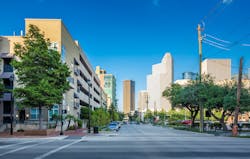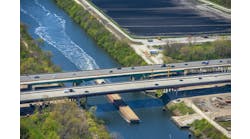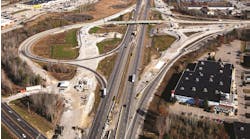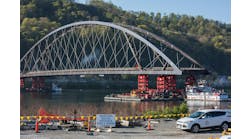Covering 10 city blocks and 3,800 linear ft of roadway, the Bagby Street Greenroads Project was effectively the first of its kind in Texas. Bagby Street is a one-way major collector that connects downtown Houston to southbound U.S. 59, and is one of the rapidly developing corridors of Midtown Houston. Because it is such a heavily used thoroughfare, Bagby Street remained open throughout construction.
The basic scope of the project comprised new storm sewers, water lines, wastewater lines, pavement, landscaping, sidewalks and traffic signals.
However, the project also was conceived as a way to provide a streetscape sensitive to the unique needs of each block in an area with a changing demographic. This meant that the development needed to be sustainable, walkable and bikeable, and possess a sense of place and community.
“We went block by block to develop a unique sense of place so it’s not a cookie-cutter solution for Bagby Street,” Lee Ann Dixon, P.E., PTOE, for Walter P. Moore, told Roads & Bridges.
The design team was granted a Major Thoroughfare and Freeway Plan amendment that designated Bagby Street as a three-lane roadway, as opposed to the four lane it had been previously. Converted to a two-lane road lined with parallel parking spaces on each side, all parallel parking spaces are protected with landscape and hardscape areas at intersections. This resulted in a 45% reduction of crosswalk length from 40 ft to 24 ft, making the road safer for pedestrians, along with other traffic-calming measures.
To blend this development with surrounding neighborhoods, paving materials, lighting fixtures and landscaping were carefully chosen to blend with the context of nearby developments. Utilities were placed in landscape areas and held back at intersections to improve visibility and safety for pedestrians.
In addition to these improvements, a new 28-ft-deep, 60-in. storm sewer was installed.
In terms of sustainability, the Walter P. Moore team practiced Low-Impact Development, an uncommon move in the city of Houston. The project incorporated innovative stormwater management features. Rain gardens filter storm water before it enters storm sewers, providing an aesthetic and educational element to the urban setting.
“These rain gardens are often used in big highway projects,” said Moore. “This is a unique application in an urban project, where the gardens become a natural feature in the dense part of the city.” R&B
Project: Bagby Street Reconstruction
Location: Houston, Texas
Owner: Midtown Redevelopment Authority of the City of Houston
Designers: Walter P. Moore and Design Workshop
Contractor: SER
Cost: $9.6 million
Start Date: July 2011
Completion Date: June 2013



